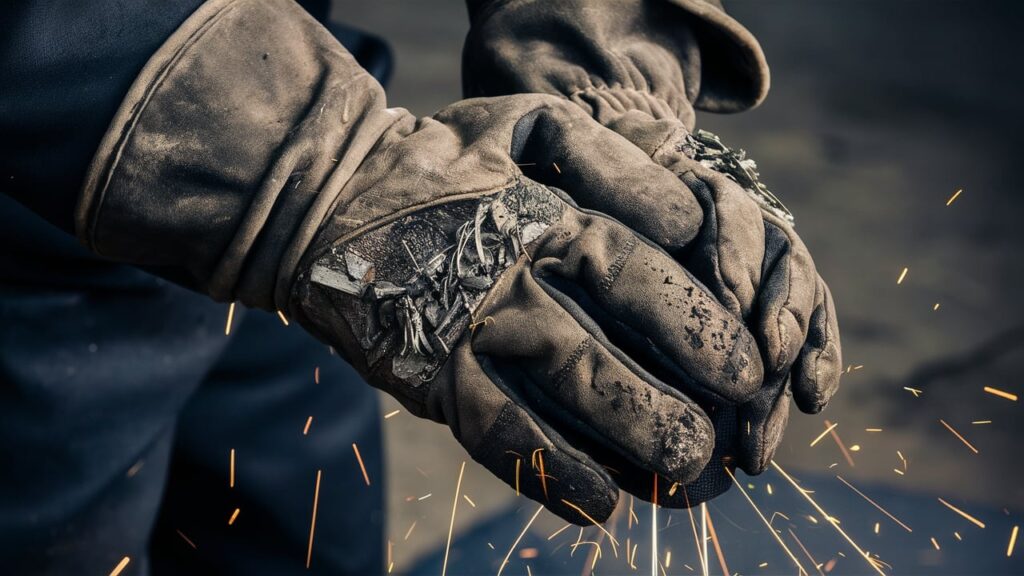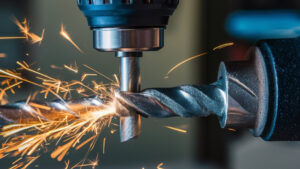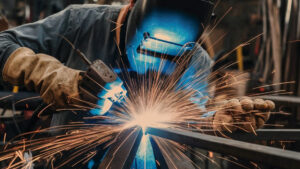Welding gloves are designed to protect hands from heat, sparks, and potential burns during welding processes. These gloves provide thermal insulation and shield hands from hot metal and flying debris.
They are crucial for ensuring the safety and well-being of welders while they work in high-temperature environments. Whether it’s professional welding or DIY projects, using welding gloves is essential to prevent accidents and injuries. In addition to heat resistance, these gloves offer dexterity and grip, allowing welders to handle equipment and materials with precision and control.
Understanding the purpose of welding gloves emphasizes their significance in maintaining safety standards and promoting efficient welding practices.
Essential Safety Gear In Welding
When it comes to welding, safety is paramount. One of the most crucial pieces of safety gear for welders is welding gloves.
Significance Of Personal Protective Equipment
Welding involves high heat and sparks, making it a hazardous activity. Proper personal protective equipment (PPE) is essential to prevent injuries.
Role Of Gloves In Welder’s Safety
Welding gloves are designed to protect the hands and forearms from burns, sparks, and electric shock during the welding process.
Welding Gloves Defined
Welding gloves are designed to protect the hands and forearms from heat, sparks, and molten metal during welding. They provide a barrier against burns, electric shock, and cuts, allowing welders to work safely and confidently. These gloves are essential for ensuring workplace safety and preventing injuries.
Welding gloves are specialized gloves designed to protect welders from the extreme heat and sparks generated during welding. These gloves are an essential part of a welder’s personal protective equipment (PPE) and play a vital role in ensuring their safety. They are made of materials that can withstand high temperatures and are designed to provide maximum protection to the welder’s hands and wrists.
Characteristics Of Welding Gloves
Welding gloves have specific characteristics that make them suitable for welding. Some of the essential characteristics of welding gloves are:
- Heat Resistance: Welding gloves are made of materials that can withstand high temperatures, protecting the welder’s hands from burns and other injuries.
- Dexterity: Welding gloves are designed to provide maximum dexterity, allowing the welder to perform complex welding tasks with ease.
- Comfort: Welding gloves are designed to be comfortable, allowing the welder to wear them for extended periods without discomfort or fatigue.
- Protection: Welding gloves are designed to provide maximum protection to the welder’s hands and wrists, protecting them from sparks, spatter, and other welding-related hazards.
Materials Used In Manufacturing
Welding gloves are made of different materials, depending on the specific welding application and the level of protection required. Some of the most commonly used materials in the manufacturing of welding gloves are:
| Material | Advantages |
|---|---|
| Leather | Durable, heat-resistant, and provides excellent protection against sparks and spatter. |
| Aluminized Fabric | Provides excellent heat resistance and reflects heat away from the welder’s hands. |
| Kevlar | Extremely durable and heat-resistant, providing excellent protection against cuts and punctures. |
| Carbon Fiber | Extremely lightweight and heat-resistant, providing excellent protection against sparks and spatter. |
In conclusion, welding gloves are an essential part of a welder’s PPE and play a vital role in ensuring their safety. They are designed to provide maximum protection to the welder’s hands and wrists while allowing them to perform complex welding tasks with ease. The materials used in their manufacturing are carefully selected to ensure that they provide the necessary level of protection while being comfortable and durable.
Heat Resistance And Insulation
Welding gloves serve the purpose of providing heat resistance and insulation during welding activities. These gloves are designed to protect the hands from high temperatures, sparks, and molten metal, ensuring the safety of the welder. With their heat-resistant materials and insulation properties, welding gloves are essential for preventing burns and injuries.
Protection From Extreme Temperatures
Welding gloves serve a vital purpose in providing protection from extreme temperatures. When working with hot metals or materials, the heat resistance offered by these gloves is crucial. Welding processes involve high temperatures that can cause severe burns or injuries if proper protection is not worn. By wearing welding gloves, welders can shield their hands and arms from the intense heat generated during welding operations.
Insulating Properties Of Glove Materials
The insulating properties of the materials used in welding gloves further enhance their effectiveness in protecting against heat. These gloves are typically made from flame-resistant materials such as leather, Kevlar, or a combination of both. The natural insulating properties of these materials enable them to withstand high temperatures and prevent heat transfer to the wearer’s hands. This insulation ensures that the heat from the welding process does not penetrate the gloves, keeping the welder’s hands safe and comfortable.
| Benefits of Welding Gloves for Heat Resistance and Insulation: |
|---|
| 1. Prevents burns and injuries caused by high temperatures |
| 2. Shields hands and arms from intense heat during welding |
| 3. Made from flame-resistant materials for enhanced safety |
| 4. Insulates against heat transfer, keeping hands safe and comfortable |
Using welding gloves with excellent heat resistance and insulation properties is essential for welders to perform their tasks safely and efficiently. These gloves not only protect against burns and injuries but also ensure that the extreme temperatures involved in welding do not hinder the welder’s ability to work effectively. By investing in high-quality welding gloves, welders can focus on their craft without worrying about the potential dangers posed by heat.
Dexterity And Comfort
When it comes to welding, ensuring both dexterity and comfort while working is essential. Welding gloves play a crucial role in providing the necessary flexibility and ergonomic design to ensure the safety and well-being of the welder. Let’s delve into the importance of these aspects in welding gloves.
Importance Of Flexibility
Flexibility is a vital aspect of welding gloves. It enables the welder to move their fingers freely and handle intricate tasks with ease. Without adequate flexibility, the gloves would hinder the welder’s ability to manipulate the welding equipment and materials, potentially compromising the quality of the weld and the safety of the individual.
Ergonomic Design For Comfort
The ergonomic design of welding gloves is aimed at providing comfort during prolonged usage. The gloves are crafted to fit the hand’s natural shape, reducing fatigue and discomfort. Additionally, the use of soft, breathable materials enhances comfort, allowing the welder to focus on their work without being hindered by hand strain or discomfort.
Durability And Longevity
Welding gloves are designed to provide durability and longevity, ensuring the safety and protection of the wearer during welding tasks. These gloves are built to withstand high temperatures, sparks, and sharp edges, offering a reliable barrier against potential hazards in the welding environment.
Durability and Longevity
Welding gloves are an essential protective gear for welders, serving the purpose of shielding their hands from potential hazards during the welding process. When it comes to welding gloves, one of the key factors that welders consider is their durability and longevity. Let’s delve into the importance of these aspects and how they contribute to the overall quality and lifespan of welding gloves.
Quality and Lifespan of Welding Gloves
When investing in welding gloves, it is crucial to prioritize quality to ensure their effectiveness and longevity. High-quality welding gloves are designed with durable materials that can withstand the harsh conditions and demands of welding work. These gloves are typically made from materials such as leather, which offers excellent heat and abrasion resistance.
The lifespan of welding gloves depends on various factors, including the quality of materials used, the frequency of use, and the level of maintenance. Properly maintained welding gloves can last significantly longer, providing welders with extended protection and value for their investment.
Maintenance for Extended Use
To maximize the lifespan of welding gloves, proper maintenance is essential. Here are some tips to help you keep your gloves in good condition for extended use:
1. Cleanliness: Regularly clean your welding gloves to remove dirt, debris, and metal particles. This prevents the accumulation of contaminants that can compromise the glove’s integrity.
2. Inspection: Before each use, inspect your gloves for any signs of wear or damage. Look for frayed stitching, holes, or thinning areas that may indicate the need for replacement.
3. Storage: Store your welding gloves in a cool, dry place away from direct sunlight. Excessive heat and moisture can degrade the materials and reduce their lifespan.
4. Avoid Chemical Exposure: Keep your gloves away from chemicals that can deteriorate the materials. If your gloves come into contact with chemicals, clean them promptly to prevent damage.
5. Proper Handling: Handle your gloves with care to prevent unnecessary strain or tearing. Avoid pulling forcefully or using excessive pressure that may weaken the glove’s structure.
By following these maintenance practices, you can extend the lifespan of your welding gloves and ensure their continued effectiveness in protecting your hands.
In conclusion, durability and longevity are vital considerations when choosing welding gloves. Investing in high-quality gloves and maintaining them properly can provide welders with the necessary protection, reducing the risk of injuries and enhancing their overall safety and comfort. Remember to prioritize quality, perform regular inspections, and implement proper maintenance practices to maximize the lifespan of your welding gloves.
Types Of Welding Gloves
When it comes to welding, safety is paramount. One crucial aspect of safety gear for welders is the welding glove. These specialized gloves protect the hands and wrists from sparks, heat, and other potential hazards. There are various types of welding gloves designed to suit different welding processes and specific tasks.
Gloves For Different Welding Processes
MIG Welding Gloves: Designed for MIG (Metal Inert Gas) welding, these gloves offer dexterity and heat resistance. They typically feature a snug fit and a high level of finger sensitivity to allow for precise welding work.
TIG Welding Gloves: TIG (Tungsten Inert Gas) welding gloves are known for their thin and flexible construction, providing excellent dexterity and maneuverability. They offer protection against heat and UV radiation while allowing welders to handle the welding torch with ease.
Stick Welding Gloves: Also known as Shielded Metal Arc Welding (SMAW) gloves, these are typically thicker and more durable to withstand the intense heat and spatter produced during stick welding. They offer robust protection and insulation.
Specialized Gloves For Specific Tasks
High-Heat Resistant Gloves: For tasks involving exceptionally high temperatures, such as working with molten metal, specialized high-heat resistant gloves are essential. These gloves are designed to withstand extreme heat and provide maximum protection.
Cut-Resistant Gloves: In addition to heat protection, some welding tasks require gloves that offer cut resistance. These gloves are constructed with materials that provide a high level of resistance to cuts and abrasions, ensuring the safety of the welder.
Leather Welding Gloves: Leather welding gloves are a versatile option suitable for various welding processes. They offer durability, heat resistance, and good dexterity, making them a popular choice among welders for general welding tasks.
Choosing The Right Pair
Factors To Consider When Selecting
1. Material quality
2. Size and fit
3. Heat and flame resistance
Matching Gloves With Welding Applications
1. TIG welding: Thin and flexible gloves
2. MIG welding: Thick and heat-resistant gloves
3. Stick welding: Heavy-duty gloves with added durability
Compliance With Safety Standards
When it comes to welding gloves, compliance with safety standards is critical. Understanding safety certifications and ensuring regulatory compliance are essential elements to consider.
Understanding Safety Certifications
Welding gloves with safety certifications guarantee protection. These certifications ensure quality and safety standards.
Ensuring Regulatory Compliance
Regulatory compliance is vital for workplace safety. Adhering to standards prevents accidents and injuries.
Common Hazards And Protection Strategies
Welding gloves serve the purpose of protecting the hands from common hazards associated with welding, such as heat, sparks, and electrical shocks. These gloves provide a barrier between the skin and the potential dangers, ensuring the safety of the welder during the welding process.
Identifying Potential Risks
Welding gloves protect against burns from sparks and hot metal.
Best Practices For Welding Safety
Choose gloves that fit well for dexterity and protection.
Welding gloves shield hands from extreme heat and sharp edges.
Proper gloves prevent burns, cuts, electric shock, and UV radiation.
Identify potential risks before starting any welding task.
Ensure gloves are made of flame-resistant materials.
Check for tears or holes in gloves regularly.
Select gloves with long cuffs for added arm protection.
Invest in high-quality gloves to ensure maximum safety.
Wear other safety gear like helmets and aprons for full protection.
Innovations In Welding Glove Technology
When it comes to the purpose of welding gloves, protection is paramount. Innovations in welding glove technology have significantly enhanced safety for welders.
Advancements In Material Science
New materials like Kevlar and Aluminized PBI provide increased heat resistance.
- Kevlar offers excellent cut and abrasion resistance.
- Aluminized PBI reflects heat and resists molten metal splash.
Future Of Welding Safety Gear
The future of welding safety gear lies in smart technologies.
- Integration of sensors to monitor temperature and alert of potential hazards.
- Enhanced ergonomic designs for improved dexterity and comfort.

Frequently Asked Questions
What Are Welding Gloves Used For?
Welding gloves are used to protect the welder’s hands and arms from heat, sparks, and electric shock during welding. They are made of durable materials that can withstand high temperatures and provide insulation against electrical currents.
What Are The Benefits Of Using Welding Gloves?
Using welding gloves provides several benefits, including protection against burns, cuts, and other injuries. They also provide a better grip on tools and materials, reducing the risk of dropping them. Additionally, welding gloves can help to improve the welder’s precision and control during the welding process.
What Materials Are Welding Gloves Made Of?
Welding gloves are typically made from heat-resistant materials such as leather, Kevlar, and Nomex. These materials provide insulation against high temperatures and protect the welder’s skin from burns and other injuries. Some gloves may also include additional layers of insulation or padding for added protection.
What Factors Should Be Considered When Choosing Welding Gloves?
When choosing welding gloves, it is important to consider factors such as the type of welding being performed, the temperature of the work environment, and the level of protection required. Other factors to consider include the fit, comfort, and durability of the gloves, as well as any additional features such as reinforced palms or extended cuffs.
Conclusion
To sum up, welding gloves serve a crucial purpose in ensuring safety and protection for welders. These specialized gloves provide insulation against heat, sparks, and potential burns, safeguarding the hands and wrists from any potential hazards during welding operations. By offering a firm grip and dexterity, welding gloves enable welders to work with confidence and precision, enhancing overall productivity.
Investing in high-quality welding gloves is essential for every welder, as it prioritizes their well-being and minimizes the risk of accidents. So, whether you’re a professional welder or a DIY enthusiast, don’t compromise on the importance of welding gloves in your welding projects.








